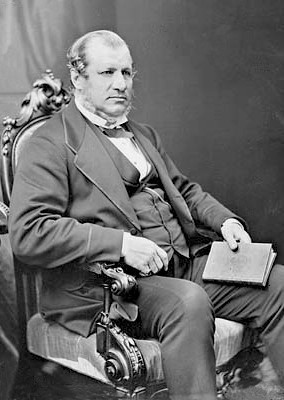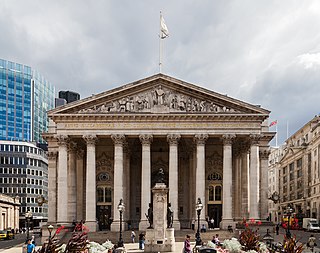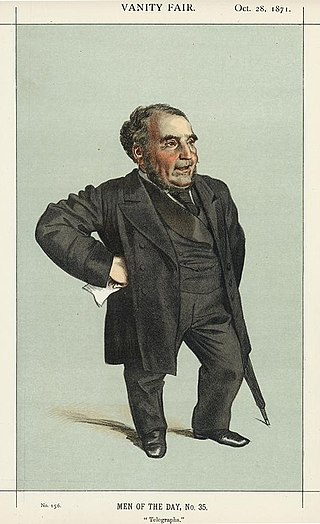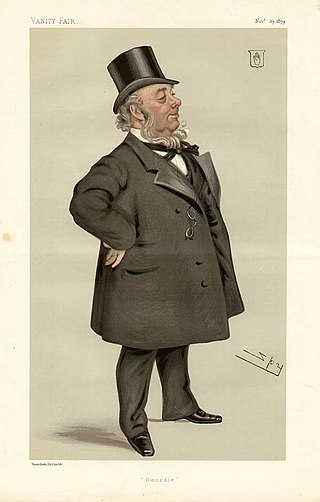Related Research Articles

The Crystal Palace was a cast iron and plate glass structure, originally built in Hyde Park, London, to house the Great Exhibition of 1851. The exhibition took place from 1 May to 15 October 1851, and more than 14,000 exhibitors from around the world gathered in its 990,000-square-foot (92,000 m2) exhibition space to display examples of technology developed in the Industrial Revolution. Designed by Joseph Paxton, the Great Exhibition building was 1,851 feet (564 m) long, with an interior height of 128 feet (39 m), and was three times the size of St Paul's Cathedral.

The Victoria and Albert Museum in London is the world's largest museum of applied arts, decorative arts and design, housing a permanent collection of over 2.8 million objects. It was founded in 1852 and named after Queen Victoria and Prince Albert.

Sir Alexander Tilloch Galt, was a politician and Founding Father of the Canadian Confederation.

The Royal Exchange in London was founded in the 16th century by the merchant Sir Thomas Gresham on the suggestion of his factor Richard Clough to act as a centre of commerce for the City of London. The site was provided by the City of London Corporation and the Worshipful Company of Mercers, who still jointly own the freehold. The original foundation was ceremonially opened by Queen Elizabeth I who granted it its "royal" title. The current neoclassical building has a trapezoidal floor plan and is flanked by Cornhill and Threadneedle Street, which converge at Bank junction in the heart of the city. It lies in the Ward of Cornhill.

Baron Pender, of Porthcurnow in the County of Cornwall, is a title in the Peerage of the United Kingdom. It was created in 1937 for the former Conservative Member of Parliament for Newmarket and Balham and Tooting, John Denison-Pender. He was the grandson of the businessman Sir John Pender, founder of a number of telegraph companies, Eastern Telegraph, Eastern and South African Telegraph, Europe and Azores Telegraph Company, Australasia and China Telegraph Company, London Platino-Brazilian Telegraph Company, Pacific and European Telegraph Company which later became Cable & Wireless. As of 2016 the title is held by the first Baron's great-grandson, the fourth Baron, who succeeded his father in 2016.

Pender Island is one of the Southern Gulf Islands located in the Salish Sea, British Columbia, Canada. Pender Island is approximately 34 km2 (13 sq mi) in area and is home to about 2,250 permanent residents, as well as a large seasonal population. Like most of the rest of the Southern Gulf Islands, Pender Island enjoys a sub-Mediterranean climate and features open farmland, rolling forested hills, several lakes and small mountains, as well as many coves and beaches.

George Washington Wilson was a pioneering Scottish photographer. In 1849, he began a career as a portrait miniaturist, switching to portrait photography in 1852. He received a contract to photograph the Royal Family, working for Queen Victoria and Prince Albert. He pioneered various techniques for outdoor photography and the mass production of photographic prints as he gradually began to largely do landscape photography in the 1860s. By 1864 he claimed to have sold over half a million copies.

The Electric Telegraph Company (ETC) was a British telegraph company founded in 1846 by William Fothergill Cooke and John Ricardo. It was the world's first public telegraph company. The equipment used was the Cooke and Wheatstone telegraph, an electrical telegraph developed a few years earlier in collaboration with Charles Wheatstone. The system had been taken up by several railway companies for signalling purposes, but in forming the company Cooke intended to open up the technology to the public at large.

Colonel Thomas Handasyd Perkins, also known as T. H. Perkins, was an American merchant, slave trader, smuggler and philanthropist from a wealthy Boston Brahmin family. Starting with bequests from his grandfather and father-in-law, he amassed a huge fortune. As a young man, he traded slaves in Saint-Domingue, worked as a maritime fur trader trading furs from the American Northwest to China, and then turned to smuggling Turkish opium into China. His philanthropic contributions include the Perkins School for the Blind, renamed in his honor; the Boston Museum of Fine Arts; McLean Hospital; along with having a hand in founding the Massachusetts General Hospital.

The Royal Crown Derby Porcelain Company is the oldest or second oldest remaining English porcelain manufacturer, based in Derby, England. The company, particularly known for its high-quality bone china, having produced tableware and ornamental items since approximately 1750. It was known as 'Derby Porcelain' until 1773, when it became 'Crown Derby', the 'Royal' being added in 1890.

Sir John Pender KCMG GCMG FSA FRSE was a Scottish submarine communications cable pioneer and politician.

Admiral Sir Charles Elliot was a British Royal Navy officer, diplomat, and colonial administrator. He became the first Administrator of Hong Kong in 1841 while serving as both Plenipotentiary and Chief Superintendent of British Trade in China. He was a key founder in the establishment of Hong Kong as a British colony.

Museums Victoria is an organisation which operates three major state-owned museums in Melbourne, Victoria: the Melbourne Museum, the Immigration Museum and Scienceworks Museum. It also manages the Royal Exhibition Building and a storage facility in Melbourne's City of Merri-bek.
The firm of James Powell and Sons, also known as Whitefriars Glass, were London-based English glassmakers, leadlighters and stained-glass window manufacturers. As Whitefriars Glass, the company existed from the 17th century, but became well known as a result of the 19th-century Gothic Revival and the demand for stained glass windows.

Sir George Elliot, 1st Baronet, JP was a mining engineer and self-made businessman from Gateshead in the North-East of England. A colliery labourer who went on to own several coal mines, he later bought a wire rope manufacturing company which manufactured the first Transatlantic telegraph cable. He was also a Conservative Party Member of Parliament (MP).

The Walker Iron Foundry was founded in 1837 by John Walker of York 'Iron & brass founder, bell-hanger & smith', at Dixon's Yard, Walmgate.

Frederick York Wolseley was an Irish-born New South Wales inventor and woolgrower who invented and developed the first commercially successful sheep shearing machinery after extensive experimentation. It revolutionised the wool industry.
Cable & Wireless Communications Ltd operating as C&W Communications is a telecommunications company which has operations in the Caribbean and Central America. It is owned by Liberty Latin America and is headquartered in Denver, Colorado, US.

Sir Richard Atwood Glass was an English telegraph cable manufacturer and a Conservative politician who sat in the House of Commons from 1868 to 1869.
Duncan & Miller Glass Company was a well-known glass manufacturing company in Washington, Pennsylvania. Items that were produced by the company are known as "Duncan glass" or "Duncan Miller glass." The company was founded in 1865 by George Duncan with his two sons and son-in-law in the South Side neighborhood of Pittsburgh, Pennsylvania. By 1890, the company joined other glass companies to form the United States Glass Company, a powerful glass trust. In 1892, the factory was destroyed in a fire, and the company was relieved of its trust relationship with the US Glass Company. After the fire, the second generation of the Duncan family moved operations to Washington, Pennsylvania. In 1900, John Ernest Miller, the company's long-time designer, became a full shareholder along with members of the Duncan family. By 1955, economic pressures from machine-produced glass forced the company to sell off its assets to the US Glass Company, who continued to produce Duncan-style glass until 1980.
References
- 1 2 Thompson, David. "Glass, Elliot & Company". Museums Victoria Collections. Museums Victoria.
- ↑ Mills, Mary (2015). Innovation, Enterprise and Change on the Greenwich Peninsula. London: M. Wright. ISBN 9780953524556.